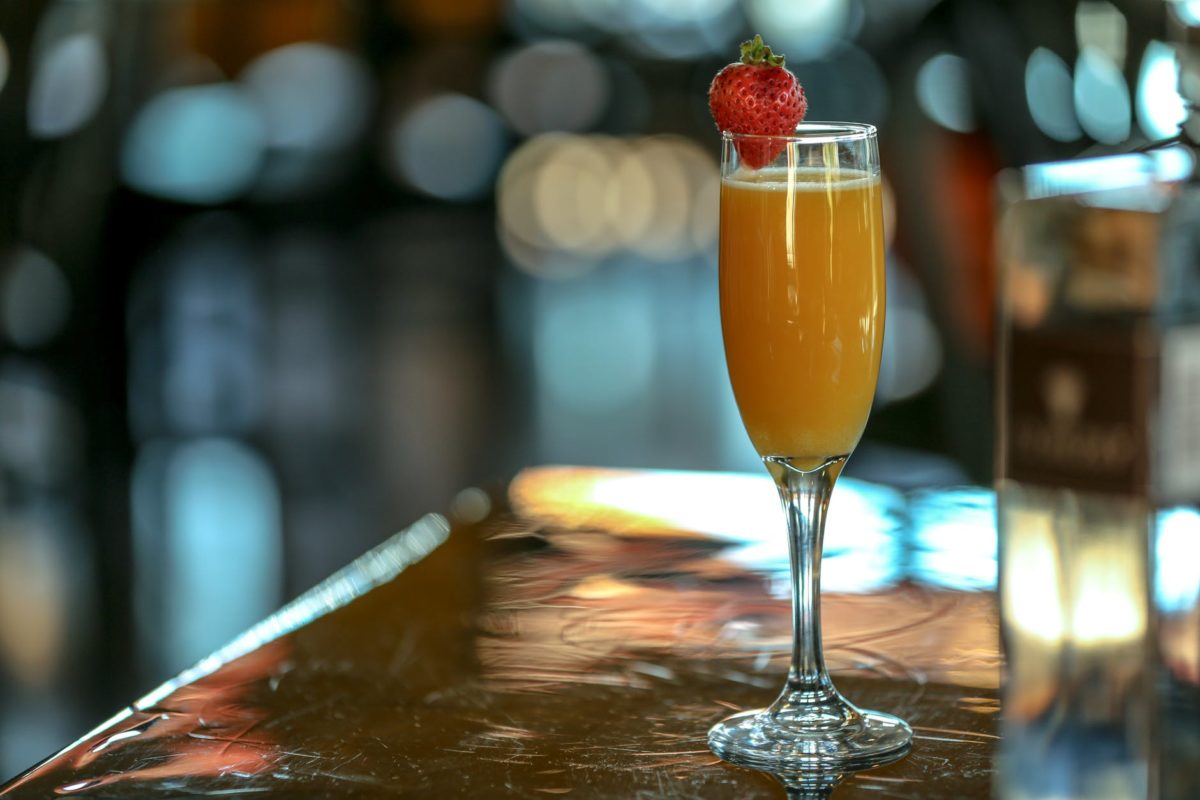
The history of the Bloody Mary, though murky, has been well covered. The Mimosa is a different story. Most published accounts assert that it was invented by bartender Frank Meier at the Ritz Bar in Paris in 1925, and many acknowledge the competing claim of the Buck’s Fizz, which debuted at Buck’s Club in London around the same time. But then everyone fast forwards 90 years to today and never explains how a European-born drink became such an icon on the American brunch table. In reality, Frank Meier probably did not invent the Mimosa. His 1934 cocktail book The Artistry Of Mixing Drinks includes the Mimosa among its 300 recipes. (“In a large wineglass: a piece of Ice, the juice of one-half orange; fill with Champagne stir and serve.”) But Meier put a symbol—his initials inside a diamond—next to the cocktails he invented and there’s no such mark next to the mimosa.
The London Observer long ago tossed cold water on the Buck’s Fizz claim, too. In 1959, the publication sniffed, “One London club likes to regard this as a specialty of the house and calls it ‘Buck’s Fizz,’ but under its native name of Champagne-orange, it has been drunk by many a Frenchman whom Buck’s would blackball on sight.”
The “Champagne-orange,” it seems, was a popular combination served in French wine country, and it was picked up and rechristened with snappier names at both the Ritz Bar and Buck’s Club. Regardless of what it was called, though, the OJ-and-Champagne combo was little known in the United States until it suddenly burst on the scene in the late 1960s. And we can thank the British royal family for that.
“The royal family has begun a new fad in drinks among London’s fashionable Mayfair set,” the Sydney Morning Herald’s London correspondent reported in 1961. “The Queen, the Duke of Edinburgh, and the Queen Mother all have adopted a Champagne cocktail they call Mimosa.”
The drink had been introduced to the Queen by Earl Mountbatten of Burma after a visit to the south of France, and it quickly spread from the royal family to “Mayfair homes and to big country houses, where the Queen and members of the royal family sometimes stay at weekends.” The royals’ version was simply iced Champagne poured over orange juice, and, notably, it was not a morning tipple but “their favorite pre-dinner drink.”
Across the pond, Sunday brunch, which had been around for decades, was becoming increasingly popular, but the Mimosa wasn’t part of it. A 1966 New York Times survey of restaurant brunch menus identified just one “Sunday brunch classic” on the beverage front: the Bloody Mary. But, the Times noted, “It does have competition from a few unexpected sources.” Those included more high-test cocktails like banana daiquiris and even double martinis. At Delmonico’s hotel, Kir (white wine and cassis) was popular, while Charley O’s, an Irish pub in Rockefeller Center, was tickling patrons’ fancy with “Champagne orange”—yes, the classic French combination of Champagne and orange juice, though with an added touch of Cointreau.
“Champagne orange” never took off in the states, because jet-setting London celebrities put the name “Mimosa” in the limelight. In May 1966, when a reporter for the London Express called round to Claridge’s Hotel to interview Alfred Hitchcock, he found the director “in fine form, drinking Mimosas (Champagne and orange juice) and smoking an eight-inch cigar.” That article was widely reprinted in American newspapers, and when Hitchcock visited New York later that year, a wire story noted that he was wearing “his customary suit of midnight (or mortician) blue” and “paused to serve Mimosa cocktails, a mixture of Champagne and fresh orange juice.”
When Vanessa Redgrave visited New York City, she was found “getting a hurry-up hairdo: and talking amid sips of “Champagne Mimosa … her pet mixture of bubbly and orange juice.” Around the same time, French actress Denise Darcel told the Detroit Free Press, “In France we drink Mimosa,” insisting it be two parts Champagne to one part orange juice and served over plenty of ice.
The Europeans made Mimosas fashionable in New York, and they soon were being served in nightclubs like the Ondine Discotheque, where “the dancing crowd … cool themselves off with Mimosas.” But it was out in New Jersey, it seems, that the Mimosa was first adopted for day-drinking.
In October 1968, the Asbury Park Press’s Night Life Roundup column mentioned a new drink called the Mimosa, which “started as a favorite of the Caribbean jet set, then hit elite New York Clubs, and now is featured at the Shandy Pub, Point Pleasant Beach.” The Shandy introduced it at the Sunday brunch “for those who can’t take ‘rough stuff’ that early in the day.” By 1971, Mimosas were being served alongside Bloody Marys and steak and eggs at the Sunday “Champagne Brunch” at The Point After Cocktail Lounge in North Bergen, “the country’s newest—and perhaps unique—nightspot.” The Point After was a football-themed nightclub complete with artificial turf on the floor and football helmet lampshades.
It took a few more years for the Mimosa to cross the Hudson and become a brunch staple in New York City. In 1977, Mimi Sheraton of the New York Times completed a 40-stop brunch tour of Manhattan, recording that the favorite drinks she encountered were “Bloody Marys, Screwdrivers, Bullshots, that Champagne and orange juice combination known as the Mimosa (occasionally laced with brandy as well) and some of the milkier drinks, such as Brandy Alexander!”
At this point, Mimosas were popping up on brunch menus in restaurants all across the country, like the Brewery in Chicago, the Old World Restaurant on Sunset Boulevard in Los Angeles, and Brighton Coach Restaurant in Dallas. Recipes for Mimosas appeared regularly in newspaper and magazine columns, and they almost all involve just mixing equal parts OJ and bubbly.
By the time Ronald Reagan was inaugurated, the Mimosa had stepped up to take equal billing with the Bloody Mary on the American brunch menu. And our poor bartenders have been chugging them out every Sunday ever since, a dozen flutes at a time.
Source: myrecipies.com




